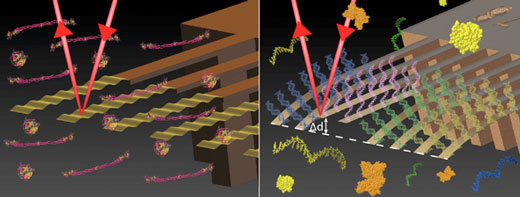A team of international researchers led by Prof Martin Hegner, Investigator in CRANN and Trinity’s School of Physics developed an automated diagnostic platform that indicates bleeding – and thrombotic risks in one drop of blood within seconds (Nanoscale, “Towards personalised rapid label free miRNA detection for cancer and liver injury diagnostics in cell lysates and blood based samples”).
They exploit micro-resonators for real-time measurements of the evolving blood plasma clot strength. Along with the clinically measured clotting time, other parameters, from specific factor deficiency to global coagulation parameters to assess fibrinolysis, can be extracted.
These technical developments now open up the possibility to introduce a miniaturized global haemostasis assay with capability to fine-tune anti-coagulation therapies.
In collaboration with the multinational Hoffman-la-Roche they report a novel strategy for quick, reliable and quantitative diagnostics of expression patterns of non-coding short RNA in blood plasma or cell cultures. They directly detect label-free specific miRNA biomarkers relevant to cancer and adverse drug effects in blood-based samples (right image).

Image Credit: CRANN
News This Week
Platelet-inspired nanoparticles could improve treatment of inflammatory diseases
Scientists have developed platelet-inspired nanoparticles that deliver anti-inflammatory drugs directly to brain-computer interface implants, doubling their effectiveness. Scientists have found a way to improve the performance of brain-computer interface (BCI) electrodes by delivering anti-inflammatory drugs directly [...]
After 150 years, a new chapter in cancer therapy is finally beginning
For decades, researchers have been looking for ways to destroy cancer cells in a targeted manner without further weakening the body. But for many patients whose immune system is severely impaired by chemotherapy or radiation, [...]
Older chemical libraries show promise for fighting resistant strains of COVID-19 virus
SARS‑CoV‑2, the virus that causes COVID-19, continues to mutate, with some newer strains becoming less responsive to current antiviral treatments like Paxlovid. Now, University of California San Diego scientists and an international team of [...]
Lower doses of immunotherapy for skin cancer give better results, study suggests
According to a new study, lower doses of approved immunotherapy for malignant melanoma can give better results against tumors, while reducing side effects. This is reported by researchers at Karolinska Institutet in the Journal of the National [...]
Researchers highlight five pathways through which microplastics can harm the brain
Microplastics could be fueling neurodegenerative diseases like Alzheimer's and Parkinson's, with a new study highlighting five ways microplastics can trigger inflammation and damage in the brain. More than 57 million people live with dementia, [...]
Tiny Metal Nanodots Obliterate Cancer Cells While Largely Sparing Healthy Tissue
Scientists have developed tiny metal-oxide particles that push cancer cells past their stress limits while sparing healthy tissue. An international team led by RMIT University has developed tiny particles called nanodots, crafted from a metallic compound, [...]
Gold Nanoclusters Could Supercharge Quantum Computers
Researchers found that gold “super atoms” can behave like the atoms in top-tier quantum systems—only far easier to scale. These tiny clusters can be customized at the molecular level, offering a powerful, tunable foundation [...]
A single shot of HPV vaccine may be enough to fight cervical cancer, study finds
WASHINGTON -- A single HPV vaccination appears just as effective as two doses at preventing the viral infection that causes cervical cancer, researchers reported Wednesday. HPV, or human papillomavirus, is very common and spread [...]














Leave A Comment